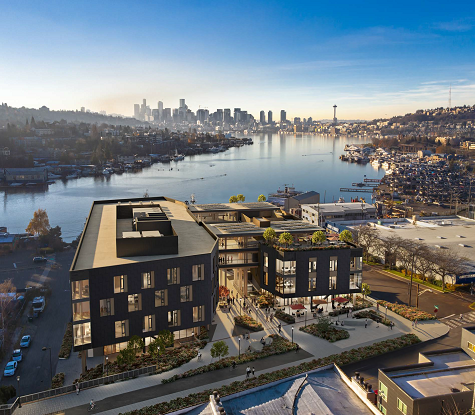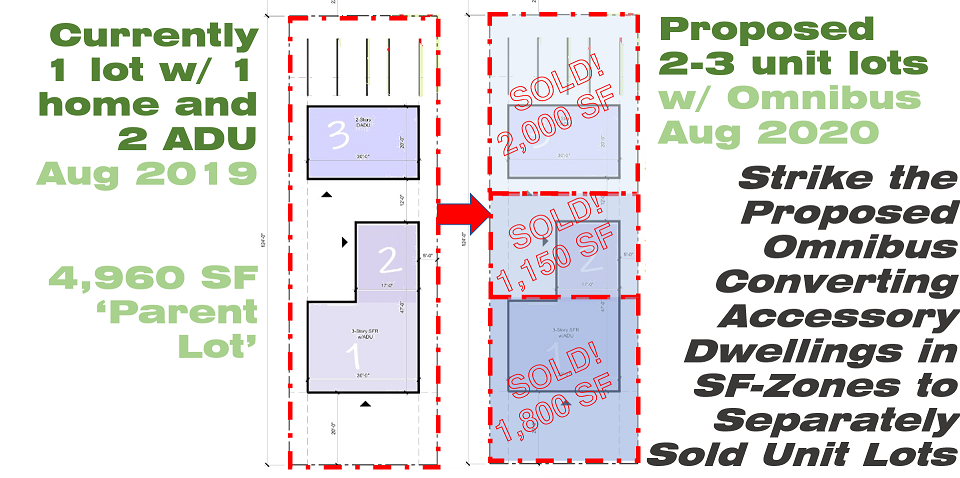Urgent CALL TO ACTION to oppose
HB1110/SB5190 which mandates statewide blanket upzones
without any guarantee of affordability.
HB1110/SB5190 seeks to dictate and override current land use laws in Seattle and statewide without any guarantee of affordability.
Please send comments to Governor Inslee, state senators in your district, and ask them to OPPOSE this bill.
Governor Inslee – fill out his contact form here, and to call: 360-902-4111
District 43rd(mostly south of 45th street)
Jamie.Pedersen@leg.wa.gov 360 786 7628
District 46 (North of 45th street)
Javier.Valdez@leg.wa.gov 360 786 7818
along with:
Chair of Ways and Means
Christine.Rolfes@leg.wa.gov 360 786 7644
One can also comment and track the bill by:
1) Going to the Washington State legislature page and click on MENU on left https://leg.wa.gov
2) Then click on “Bill Information” on list and then type in search bar the bill number “1110” only (do not include the HB prefix), then click “search”
3) Click “Comment on this bill” and fill in your name, address, and zip to verify your legislators
5) You can choose to “oppose,” “neutral,” or “support” and leave comments
6) Lastly be sure to “send comment” or “submit” (make a copy for your records, optional)
Here are the core excerpts from the original bill HB1110 and substitute bills:
1) Any city with a population of 75,000 or more … must provide statewide … authorization for the following:
a) The development of at least FOUR units per lot on all lots zoned for residential use,
b) The development of SIX units per lot on all lots zoned predominantly for residential use within ½ mile walking distance of a “Major transit stop or community amenity” and,
c) The development of SIX units per lot on all lots zoned predominantly for residential use, if at least two units are affordable housing.
Note b above: “major transit stop” definition has expanded to include, “community amenity” of about 200 public schools in Seattle and 300 parks within one half mile
Note b above: Amendments to reduce the 1/2 mile to 1/4 mile have failed in latest substitute bill and to the request to omit parks and schools denied
Note c above: “major transit stop” definition includes light rail, rapid ride, bus stops with regular service qualifications
d) To qualify for the additional units … the applicant must commit to renting two of the six units at rents affordable to low-income households (60% AMI renters and 80% AMI buyers) for a term of 50 years.
Note: this option of providing two units of affordable housing is only available if the building location is outside the ½ mile and the developer wants to increase production from four units to six units, AND, as almost all of Seattle is “within ½ mile walking distance of a, “Major transit stop or community amenity,” this incentive to add affordable housing units is negated by the above 1.b. Essentially, this bill provides no incentive to build affordable housing units within Seattle and gives away negotiation power that could be used to ask for it.
Edmonds News, Reader View, Feb. 5, 2023, says it succinctly:
“There is no upside to these bills. Failure to build affordable housing, override of local zoning ordinances, negative impact of development on our environmental resources (watersheds, critical areas, tree canopy) and on our aging infrastructure, and inevitable future property tax increases, are all serious downsides.”
Background reading links for HB1110/SB5190:
1) Seattle Times Jan. 27, 2023 “Serve the people, not the developers”
https://www.seattletimes.com/opinion/editorials/serve-the-people-not-developers-amend-middle-housing-bill/
“HB 1110 includes no authentic proscription to create affordable housing. Instead, it creates market-rate housing.”
2) Seattle Fair Growth Missing Middle Fact Sheet
https://www.seattlefairgrowth.org/missing-middle-fact-sheet.html
3) District 4 Council Alex Pedersen News in Land Use section” Reasons to Reject HB1110/SB5190”
https://mailchi.mp/seattle.gov/so-much-to-accomplish-in-2023?e=af260c3273#land-use
4) Edmonds News Feb. 17th, 2023
https://myedmondsnews.com/2023/02/reader-view-who-will-benefit-from-house-and-senate-housing-bills-follow-the-money
Not only are the so-called “Missing Middle” House bills examples of using language to mislead, but both “Missing Middle” bills HB1110/SB5190 are statewide mandates to override and pre-empt Seattle’s local zoning laws.
Briefly, we need to reflect on Seattle’s sweeping blanket up zone legislation passed in 2019 which included MHA (Mandatory Housing Affordability) that eliminated all single-family zoned lots within 27 Urban Villages. All single-family lots inside these 27 Urban Villages were converted to higher density multi-family low rise zones. Also, Seattle increased development capacity with massive upzones in Neighborhood Commercial zones and hubs such as downtown, Ballard, and the U District.
Additionally, the 2019 ADU/DADU attached and detached backyard cottage legislation up zoned every single-family lot citywide outside of the urban villages to allow 3 units per lot, citywide. That has evolved into unit lot subdivisions, generating the development of townhouses, being sold for a median listing price of $769K1. Currently, developers can maximize profits by tearing down one house and selling or leasing 3 units at market rates in single family zones citywide.
Both of these sweeping changes to zoning are having the effect of decreasing the amount of naturally occurring affordable housing throughout Seattle faster than any affordable housing is being generated. At least with the Seattle urban village MHA up zones, there is a development fee collected which transfers to non-profits to build affordable housing at a range of income levels.
Some key reasons to reject or oppose HB1110/SB5190
- Seattle residents should be in control of land use zoning decisions for Seattle
- Seattle has sufficient capacity for growth, and the 2019 MHA and ADU/DADU upzones increased this capacity even further
- More than 80% of the 250,000 needed units of housing in WA are low-income, subsidized housing, and that will not be addressed by upzoning; subsidies and incentives are needed.
- Upzoning drives displacement, as it encourages tear downs of naturally occurring affordable housing within neighborhoods, as well as economic segregation by replacing what was once affordable to a broader swath of income levels with new market rate housing units.
- HB1110 /5190 is going to produce market rate housing with zero affordability requirements within a ½ mile from parks, schools and transit (so no affordability requirements for most of Seattle)
- Infrastructure language is inadequate for level of density mandated
- Upzones in Seattle have caused property assessments to rise, dramatically increasing property taxes over the past few years
- Environmental concerns such as such as tree canopies, setbacks, watersheds and run-off, critical areas prone to flooding, erosion, and landslides, and green space inclusion are being ignored at the expense of the quality of life for residents of all incomes
—Reference:
- Redfin.com, on March 5, 2023 states, “There are currently 453 townhouses for sale in Seattle at a median listing price of $769K.” https://www.redfin.com/city/16163/WA/Seattle/townhouses


